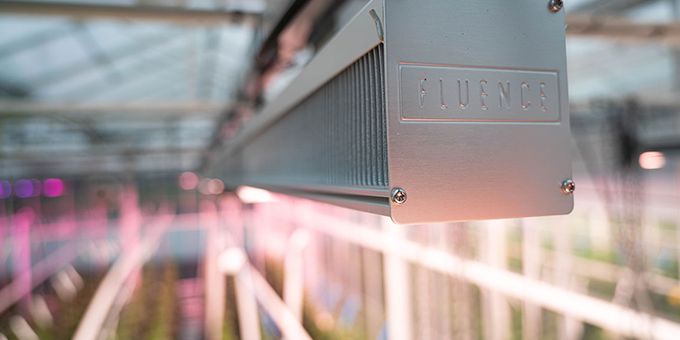Plants respond differently to various spectra so choosing the best LEDs for you will depend on your specific cultivation goals and crops, location and climate, and several other key considerations.
 Choosing the Right LEDs for Your Greenhouse
Choosing the Right LEDs for Your Greenhouse

Article from | Fluence OSRAM
Part I: Spectra
LED systems are designed to emit a wide variety of wavebands. For growers considering an LED retrofit, the added functionality—and potential—of broad-spectrum lighting strategies can be intimidating. Questions about cultivar spectrum sensitivity and plant response, facility upgrades or adjustments, operational best practices, changes in environmental conditions, and a host of other factors dictate the decision-making process.
Plants respond differently to various spectra so choosingthe best LEDs for you will depend on your specific cultivation goals and crops, location and climate, and several other key considerations. But, with the right strategy, cultivators can precisely target photoreceptors and pigments for enhanced control of morphology, flowering, and additional characteristics that drive top-line performance.
Physics meets photobiology: How LEDs work to support your crops
An LED is a pairing of semiconductors that emits light when voltage is applied. As electrons migrate from one material to another, they lose energy and release it as light.
The type of light and the amount of power required to fuel it depend on the electrical properties used to craft specific LED products and spectrums.
That said, not all crops respond to spectra in the same way, and growers are often tasked with selecting a spectrum that can range from dual-band red and blue—known colloquially as narrow-band or pink light—and various broad-band options that contain more balance across the PAR spectrum. Notably, broad-bands contain fractions of green light and various percentages of red light.
Additionally, some LED lighting types are more energy efficient, generate greater crop yields, and even improve production.
Pink light
Blue and red wave bands are critical to plants because the two primary chlorophylls in plants—chlorophyll a and b—absorb blue (450 nm) and red (660 nm) especially well.
Blue and red LEDs are also among some of the most energy-efficient LED types, which is perfect for those in need of high-efficiency, narrow-band fixtures.
A narrow band or monoband supplement, such as the Fluence DUAL R9B, can be helpful for achieving specific photo responses that include rooting, flowering or compact growth. Narrow-band fixtures also produce more µmol/J than broad-spectrum fixtures, making them perfect for greenhouses where natural sunlight is abundant. In other words, narrow-band fixtures that supplement ample sunlight (middle spectrum wavelengths) save energy without sacrificing plant quality.
In the absence of year-round broad-spectrum light, a heavily polarized spectrum may negatively impact morphology, flowering and product quality. This brings us to broad-spectrum LEDs.
For growers evaluating whether they should pursue a narrow band or a broad spectrum, it’s critical to know whether or not the cultivars you grow will respond equally well to each respective spectrum. If so, a narrow spectrum may well be the best option, since narrow spectra are more energy efficient than broad spectra. However, many crops simply perform better under a broad spectrum because it contains more usable wavelengths. In such cases, the efficiency gains of using a narrow spectrum are largely negated by suboptimal plant performance, such as reduced morphology and yields.
Broad-spectrum LEDs
The misconception that plants do not benefit from middle-spectrum wavelengths like green light has been disproven. In reality, plants can benefit significantly from a balanced spectrum with a fraction of green light becauseit drives photosynthesis more efficiently than spectra with high red and far red ratios.
White LEDs contain wave bands that include green and amber light, which are typically blue LEDs that have been coated with a yellow phosphor to modify their spectra.
Although they may be less efficient than the previous LED types, they are more efficient than dedicated green LEDs, and they further allow engineers access to the middle spectrum at the lowest possible electrical consumption level.
Broad-spectrum sunlight is typically the best “umbrella” option for a majority of crop types. However, some cultivators avoid implementing broad-spectrum LEDs in their greenhouses due to a range of factors and unique circumstances. We encourage growers to consult with a lighting designer and our horticulture services team to explore whether a more balanced spectrum like Fluence R4 or R6 can yield better morphology and quality.
Lighting ergonomics
Of course, when considering greenhouse lighting, crop health isn’t the only factor—there is also the wellness of those working in the greenhouse.
The human eye adapts well to green light, but we struggle with narrow-band blue and red lighting. What is interesting, growers often struggle with harvesting, assessing the ripeness of crops, and identifying and eliminating pests when working in spaces dominated by pink light
Other helpers such as insects also need a broader spectrum that imitates natural sunlight. Without blue and green light, bumblebees have a difficult time navigating crops and pollinating greenhouses effectively. On the other hand, parasitic wasps and other harmful pests may actually be more effective in ultraviolet, blue and green light.
Put simply, understanding how a given spectrum impacts not only your plants but also your workers is instrumental to developing the right system for you.
Get started with Fluence
Finding the right LEDs for your setup is an essential process that can be confusing on your own. But rest assured–Fluence is on your side and in your corner. Contact us today for a custom design and strategy that meets your unique cultivation goals and operation.
The content & opinions in this article are the author’s and do not necessarily represent the views of AgriTechTomorrow
Comments (0)
This post does not have any comments. Be the first to leave a comment below.
Featured Product

